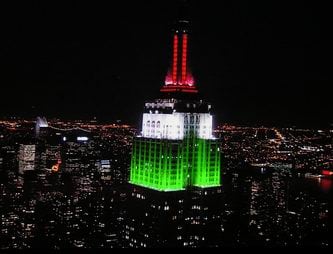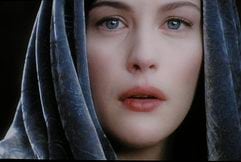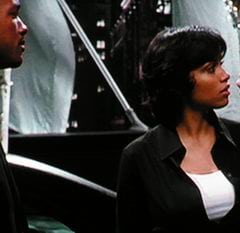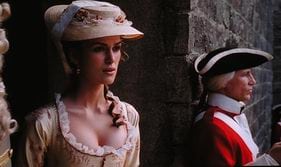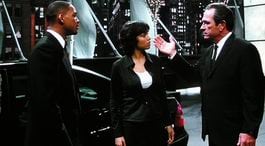Marantz VP-12S4: Image Quality
WOW! Some months ago, I reviewed JVC's HD2K D-ILA 3 chip projector, and raved about it. Compared to my own BenQ 8700+ projector, it not only had the advantage of being a true 1080 resolution projector, but overall produced an image that was in virtually all ways, superior to my BenQ. If it lacked anything, it was contrast ratio, where it was barely up to the BenQ. However, the overall image was such that it took about a week after returning the JVC eval unit, before I could start enjoying the BenQ again.
This time, I think its going to take a lot more than a week. While that JVC projector still has a resolution advantage over this Marantz projector, the overall image quality difference between the Marantz VP-12S4 and the BenQ is far more striking. For that reason you will see below lots of side by side images where I viewed the Marantz projector side by side from the same sources (DVD, D-VHS), on my double wide test screen. (Stewart, matte white). This screen allows me to project two 100" diagonal 16:9 images (actually 98") side by side from the same sources using a splitter/amplifier. Since my BenQ 8700+ is ceiling mounted, and this screen is not in my theater, for comparison purposes I was able to view the Marantz projector side by side against the same BenQ PE7700 (the projector that recently replaced the BenQ 8700+), that I used for its review last month.
You will find the differences to be striking - to say the least. Now the BenQ PE7700 home theater projector sells for around $3000, its only fair that a projector that sells for almost five times the price should outperform it, but I was still overwhelmed by how great the differences are. Everyday people who have watched my theater system, are always dazzled, and when I tell them that it can be drastically better, they are skeptical. If they only saw the differences I talk about here.
I touched on brightness before. The Marantz projector is rated 700 lumens, and has plenty of muscle for most home theater installations. I have no doubt that it will be more than sufficiently bright on my new 128" diagonal Firehawk when it arrives. (The Firehawk has a gain of 1.3.) Of course there are many factors that need to be considered. Dark walls reflect far, far less ambient light back on to the screen, and can make a huge difference. The Marantz Darkchip 3 based DLP projector's contrast and black levels are so good, that a high contrast screen with gain, - like the Firehawk, work just great. Although if you opt for a small screen - say 92" or less, you might want to go high contrast gray screen (ie. the Grayhawk), since you'll have plenty of "horsepower", and teh gray surface will make those near blacks a bit closer to true black.
Where the VP-12S4 really shines though, is in its ability to handle blacks. It is so much better than the BenQ, that I was really surprised. It was immediately, and obviously noticeable in my theater, with the few minutes it takes me to switch from one projector to the other, but when viewing the Marantz projector side by side against the BenQ 7700, the differences where - literally night and day. Using my Over America Hi-Def D-VHS tape (outputting component at 1080i), and viewing the New York skyline near dusk, you can see that the BenQ PE7700 (right side image) seems to have great contrast, and good blacks, but the scene itself looks like night time. By comparison, on the left, the Marantz captures what is on the tape. The footage was shot at dusk with that pinkish orange caste hitting all the buildings. The difference is so huge its like the Marantz was projecting an image from 10 minutes before sundown, and the BenQ - an hour and a half later - night time! Until this side by side, I never realized how much of the original content was "Lost in Translation" on the BenQ projector.
At the bottom of the page, I have two larger and partially zoomed in images of the scene above (Marantz and BenQ projectors, for your closer examination.
Flesh tones overall were excellent. The Marantz uses 10 bit processing - per color, 30 bits total - (over 1 billion colors) as compared to most home theater projectors which use standard 24 bit (8 bit per color), and 16 million color palette. This allows the Marantz to have dozens and dozens of shades on a person's cheek, instead of only a handful. While typical projectors do fine, there is always a bit of mottling - not enough different shades to smoothly produce the shades on a cheek. The Marantz projector, by comparison was virtually flawless. The shot of Awen (right) from Lord of the Rings, also picks up more color saturation than the BenQ and most other projectors. The actual footage is designed to paint her features a very pale, almost grayish. With the Marantz the saturation brings out the actual flesh tints lost on many other projectors.
I spent a lot of time focusing on imagery that tests the ability of projectors to do blacks and near blacks - the "holy grail" of non-CRT projectors. Here you can see images from Men in Black II. Believe me, any shadow detail missing is more the result of the limitations of my digital camera, than the projector itself. In the picture immediately below from Pirates of the
Carribean, you can see plenty of detail in the shaded section of stone wall. On my BenQ projector, much of that is lost. At the same time, note that you are seeing rich vibrant reds on the soldier's uniform.
The image captured from the Hawaiin Tropic DVHS tape on the Marantz, you get an idea of how well the Marantz VP-12S4 can handle scenes with lots of blacks and near blacks, and at the same time very bright areas.
(Note: my digital camera has less ability to capture the range from white to black, than most projectors can. As a result, if I set exposures so you can see the black detail, the near whites are often blown out - pure white - lacking detail. This is a camera limitation, not a fault of the projectors I test. (Note, some projectors do have significantly more range than others.)
Motion Artifacts
Although I am very pleased with the quality of my BenQ (and the even better BenQ PE7700), in my side by side between the PE7700 and the Marantz DLP projector, differences were evident. When the Over America DVHS (1080i) pans across some skyscrapers, the BenQ - which did better than most projectors I have worked with - definitely had more motion artifacts going then the Marantz - in fact the Marantz in this test, was near flawless by comparison. (Note, you probably wouldn't have a complaint with the BenQ, the Marantz just takes it to another level.) On DVD sources, clean is the operative word. Marantz speaks of their jointly engineered technologies (they partner with Gennum), including adaptive motion de-interlacing (on HD sources as well as DVD and other lower res sources.
Picture Noise
What noise? The image is near rock stable in the darkest areas where noise is normally evident. Congrats to the engineers that pulled this off. You can wall up to a couple of feet from the screen and see some noise, but at normal viewing distances, its about as clean as you could hope for.
Projector Pixelization - Screen Door Effect
The pixels are less visible than on my BenQ projector. This should be the direct result of the changes in the design of the DLP chip from the old HD2+ to the DarkChip 3. If you get close, the pixels are still more visible than D-ILA (LCOS) projectors, but you aren't likely to notice pixels at all, except on typical credits (white letters on black...) at normal seating distances. I believe some people will be satisfied with the lack of visibility of pixels from distances as little as 1.0 x screen width - or roughly 7 feet back from a 100" screen. For most of us, 1.2 times screen width is more than sufficient distance to make pixels a non-issue.
Any Crushed Blacks, Crushed Whites?
For those not following the "techie" terminologies, blacks that are "crushed" simply means that you (when viewing a really dark area) information is lost since the projector can't produce perfect blacks. All that detail in the near dark areas is the same brightness as the darkest black the projector can produce. The result - no information (detail), just a very even black area. You can typically notice this when viewing people in black clothing - the details of the black suit or other article of clothing are just not there. Same can be true of any near dark area. The scene from The Fugitive when the train is approaching the bus at night is an excellent example (sorry no image) - on most projectors you see almost nothing except the light from the front of the train. A projector like the Marantz isn't perfect, but it sure gets about as close to resolving all that detail as any projector not using CRT technologies (and CRT projectors, believe me, - have penty of their own issues).
Whites will crush too. A white shirt or almost white wall may lose detail instead of showing subtle details. Setting your projector for more brightness/contrast will typically crush white detail.
All that said, the Marantz, again, performs beautifully. Black crush is as nearly non-existant as you can hope to find in a DLP, LCD, or LCOS projector. Proper calibration should further negate any crush. On the image above (Empire State Building at night) there is plenty of information (detail) in the many buildings. There is some "white crush" visible in the white light illuminated part of the building, but that's the best my digital camera could do. In reality, watching the Marantz 12S4, you can see detail in the white illuminated section of the building, that is lost in this photo.



